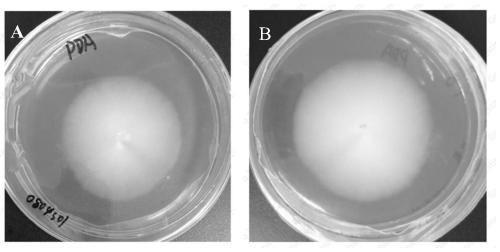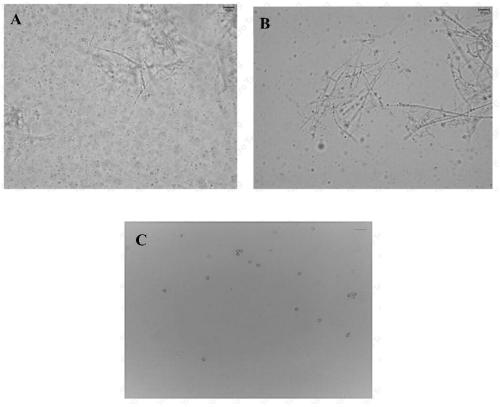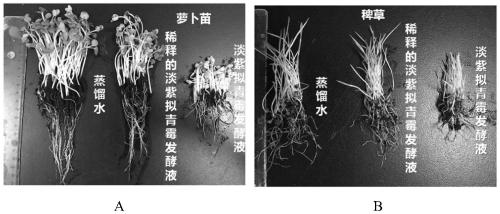Paecilomyces lilacinus and application thereof in inhibiting plant growth
A technology of Paecilomyces lilacinus and strains, applied in the field of microorganisms, can solve problems such as the increase of drug-resistant weed populations, excessive pesticide residues in the soil, and river pollution, etc., to prolong the germination time, the effect is obvious, and the effect of inhibiting germination
- Summary
- Abstract
- Description
- Claims
- Application Information
AI Technical Summary
Problems solved by technology
Method used
Image
Examples
Embodiment 1
[0055] The screening, separation and identification of embodiment 1 Paecilomyces lilacinus
[0056] 1. Isolation and purification of bacterial strains
[0057] Wash the stems and roots of purslane (from a certain place in Guangzhou, Guangdong) with tap water, dry them in the air, soak them in 75% (w / w) alcohol for 2 minutes, rinse them with sterile water, and rinse them with 0.1% (w / w) mercuric chloride Soak for 1.5min, rinse with sterile water; wash leaves with tap water, dry, soak in 75% (w / w) alcohol for 2min, rinse with sterile water, soak in 0.1% (w / w) mercuric chloride for 30s, rinse with sterile water rinse. The sterile water-coated plate (LB) cleaned for the last time was used as a blank control to exclude microbial interference on the surface of purslane, and the roots, stems and leaves were cut into small pieces and planted on PDA medium, and cultivated in a 28°C incubator. The grown bacteria were continuously purified by the plate line drawing method until they be...
Embodiment 2
[0067] The influence of different solvent extracts of embodiment 2 Paecilomyces lilacinus culture fluid on plant growth
[0068] (1) Prepare 1 L of PDB culture solution (ie, liquid PDB medium), put it into a 2 L Erlenmeyer flask, seal it, and sterilize it under high temperature and high pressure at 121°C for 30 minutes before use. Under sterile conditions, Paecilomyces lilacinus Scaumcx04 (a strain with a diameter of 0.5 cm) was inoculated in shake flasks filled with PDB culture solution, and then the inoculated shake flasks were placed on a shaker for 7 days, and the shaker The temperature is 28°C and the rotation speed is 180r / min. After culturing for one week, the culture solution was taken out to obtain the corresponding endophytic bacteria solution.
[0069] (2) Filter the obtained bacterial liquid with gauze (to remove large truffles) to obtain the supernatant, and divide it into three equal parts, then add an equal volume of n-butanol, ethyl acetate and petroleum in th...
Embodiment 3
[0077] Embodiment 3, the influence of the ethyl acetate extract of Paecilomyces lilacinus culture fluid on the growth of different plants
[0078] (1) Prepare 1L of PDB culture solution, put it into a 2L Erlenmeyer flask, seal it, and sterilize it under high temperature and high pressure at 121°C for 30 minutes before use. Under sterile conditions, Paecilomyces lilacinus Scaumcx04 (a strain with a diameter of 0.5 cm) was inoculated in shake flasks filled with PDB culture solution, and then the inoculated shake flasks were placed on a shaker for 7 days, and the shaker The temperature is 28°C and the rotation speed is 180r / min. After culturing for one week, the culture solution was taken out to obtain the corresponding endophytic bacteria solution.
[0079](2) Filter the obtained bacterial solution with gauze to obtain a supernatant, and then add an equal volume of ethyl acetate to the supernatant for extraction. After extraction, the obtained organic phase was transferred to ...
PUM
 Login to View More
Login to View More Abstract
Description
Claims
Application Information
 Login to View More
Login to View More - R&D
- Intellectual Property
- Life Sciences
- Materials
- Tech Scout
- Unparalleled Data Quality
- Higher Quality Content
- 60% Fewer Hallucinations
Browse by: Latest US Patents, China's latest patents, Technical Efficacy Thesaurus, Application Domain, Technology Topic, Popular Technical Reports.
© 2025 PatSnap. All rights reserved.Legal|Privacy policy|Modern Slavery Act Transparency Statement|Sitemap|About US| Contact US: help@patsnap.com



